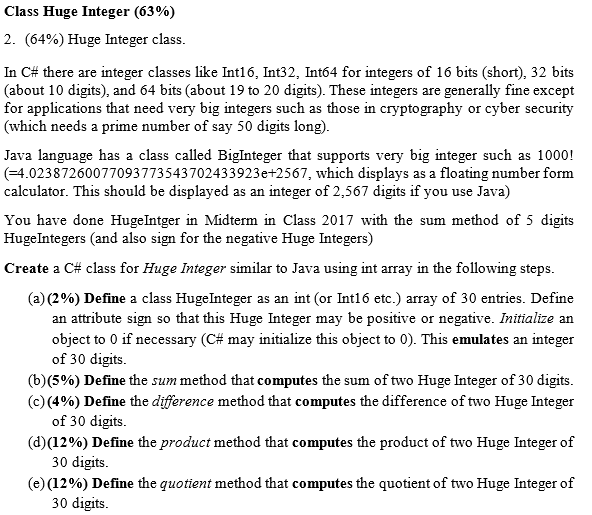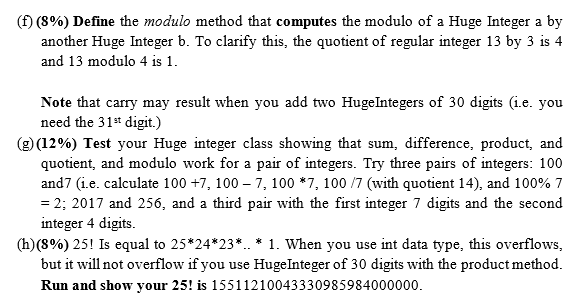

Class Huge Integer (63%) 2. (64%) Huge Integer class In C# there are integer classes like Int16, Int32, Int64 for integers of 16 bits (short), 32 bits (about 10 digits), and 64 bits (about 19 to 20 digits). These integers are generally fine except for applications that need very big integers such as those in cryptography or cyber security (which needs a prime number of say 50 digits long) Java language has a class called BigInteger that supports very big integer such as 1000! (4.02387260077093773543702433923e+2567, which displays as a floating number form calculator. This should be displayed as an integer of 2,567 digits if you use Java) You have done HugeIntger in Midterm in Class 2017 with the sum method of 5 digits HugeIntegers (and also sign for the negative Huge Integers) Create a C# class for Huge Integer similar to Java using int array in the following steps (a) (296) Define a class Hugelnteger as an int (or Int16 etc.) array of 30 entries. Define an attribute sign so that this Huge Integer may be positive or negative. Initialize an object to 0 if necessary (C# may initialize this object to 0). This emulates an integer of 30 digits (b)(5%) Define the sum method that computes the sum of two Huge Integer of 30 digits (c)(4%) Define the difference method that computes the difference of two Huge Integer of 30 digits 30 digits 30 digits (d)(12%) Define the product method that computes the product of two Huge Integer of (e) (12%) Define the quotient method that computes the quotient of two Huge Integer of Class Huge Integer (63%) 2. (64%) Huge Integer class In C# there are integer classes like Int16, Int32, Int64 for integers of 16 bits (short), 32 bits (about 10 digits), and 64 bits (about 19 to 20 digits). These integers are generally fine except for applications that need very big integers such as those in cryptography or cyber security (which needs a prime number of say 50 digits long) Java language has a class called BigInteger that supports very big integer such as 1000! (4.02387260077093773543702433923e+2567, which displays as a floating number form calculator. This should be displayed as an integer of 2,567 digits if you use Java) You have done HugeIntger in Midterm in Class 2017 with the sum method of 5 digits HugeIntegers (and also sign for the negative Huge Integers) Create a C# class for Huge Integer similar to Java using int array in the following steps (a) (296) Define a class Hugelnteger as an int (or Int16 etc.) array of 30 entries. Define an attribute sign so that this Huge Integer may be positive or negative. Initialize an object to 0 if necessary (C# may initialize this object to 0). This emulates an integer of 30 digits (b)(5%) Define the sum method that computes the sum of two Huge Integer of 30 digits (c)(4%) Define the difference method that computes the difference of two Huge Integer of 30 digits 30 digits 30 digits (d)(12%) Define the product method that computes the product of two Huge Integer of (e) (12%) Define the quotient method that computes the quotient of two Huge Integer of








